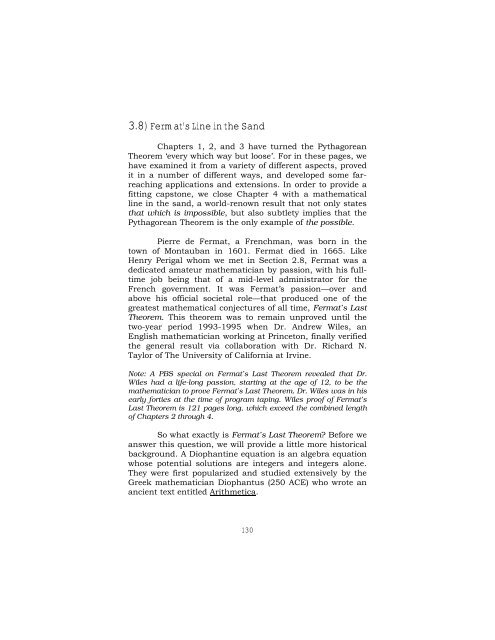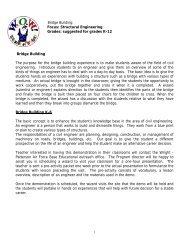The Pythagorean Theorem - Educational Outreach
The Pythagorean Theorem - Educational Outreach
The Pythagorean Theorem - Educational Outreach
- No tags were found...
You also want an ePaper? Increase the reach of your titles
YUMPU automatically turns print PDFs into web optimized ePapers that Google loves.
3.8) Fermat’s Line in the SandChapters 1, 2, and 3 have turned the <strong>Pythagorean</strong><strong>The</strong>orem ‘every which way but loose’. For in these pages, wehave examined it from a variety of different aspects, provedit in a number of different ways, and developed some farreachingapplications and extensions. In order to provide afitting capstone, we close Chapter 4 with a mathematicalline in the sand, a world-renown result that not only statesthat which is impossible, but also subtlety implies that the<strong>Pythagorean</strong> <strong>The</strong>orem is the only example of the possible.Pierre de Fermat, a Frenchman, was born in thetown of Montauban in 1601. Fermat died in 1665. LikeHenry Perigal whom we met in Section 2.8, Fermat was adedicated amateur mathematician by passion, with his fulltimejob being that of a mid-level administrator for theFrench government. It was Fermat’s passion—over andabove his official societal role—that produced one of thegreatest mathematical conjectures of all time, Fermat’s Last<strong>The</strong>orem. This theorem was to remain unproved until thetwo-year period 1993-1995 when Dr. Andrew Wiles, anEnglish mathematician working at Princeton, finally verifiedthe general result via collaboration with Dr. Richard N.Taylor of <strong>The</strong> University of California at Irvine.Note: A PBS special on Fermat’s Last <strong>The</strong>orem revealed that Dr.Wiles had a life-long passion, starting at the age of 12, to be themathematician to prove Fermat’s Last <strong>The</strong>orem. Dr. Wiles was in hisearly forties at the time of program taping. Wiles proof of Fermat’sLast <strong>The</strong>orem is 121 pages long, which exceed the combined lengthof Chapters 2 through 4.So what exactly is Fermat’s Last <strong>The</strong>orem? Before weanswer this question, we will provide a little more historicalbackground. A Diophantine equation is an algebra equationwhose potential solutions are integers and integers alone.<strong>The</strong>y were first popularized and studied extensively by theGreek mathematician Diophantus (250 ACE) who wrote anancient text entitled Arithmetica.130

















